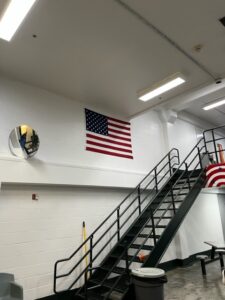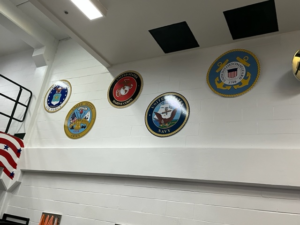 At one time, they were serving their country. Once members of the Army, Marines, Navy, Air Force, or Coast Guard, now they wear jumpsuits and reside in the Clay County Jail. Recently, Clay County Sheriff Michelle Cook shared with a group of citizens about the hard work being done in the jail and the creation of a special dorm for those who once wore the uniform. Some know the housing unit as G-1, but it is increasingly being identified as Veterans Dorm, and, on this day we are going behind bars to learn what makes the Veterans Dorm a success.
At one time, they were serving their country. Once members of the Army, Marines, Navy, Air Force, or Coast Guard, now they wear jumpsuits and reside in the Clay County Jail. Recently, Clay County Sheriff Michelle Cook shared with a group of citizens about the hard work being done in the jail and the creation of a special dorm for those who once wore the uniform. Some know the housing unit as G-1, but it is increasingly being identified as Veterans Dorm, and, on this day we are going behind bars to learn what makes the Veterans Dorm a success.
After a briefing by Director Joseph Bucci, he assigned Clay County Sheriff’s Office Lt. Harwood to lead us through the maze formed by multiple jail expansions over the years until we reach the hardened glass and doors that make up the entrance to the Veterans Dorm. As we entered the two-tiered room, inmates stepped to the end of their bunks and continued standing in place until we exited the dorm several moments later. The dorm has twenty standard bunks with the ability to expand to twenty-two with the addition of portable bedding units known as floats. Today, the census in G1 is 9 inmates, so no floats are needed. However, several items are present in this dorm not found in other housing areas within the jail. Instantly visible are a large American flag, the seal of each branch of Armed Forces, and a painted patriotic banner that stretches the width of the room.
When asked about any special privileges that inmates in the Veterans Dorm receive, Lt. Harwood points to a larger television on the wall, a dedicated book rack that does not have to be shared with other dorms, twice the recreational time, newspapers and magazines provided at no cost to the inmates, and the ability to attend any program offered at the jail. Regarding the responsibilities within this special housing unit, Lt. Harwood explains that the standard for care and cleanliness of this facility is much higher. The results of this higher standard are obvious. Beds made (sharply); towels hung in organized fashion; floors, toilets and showers scrubbed clean; and no markings or damage on the walls.
In addition to these patriotic reminders, a large placard containing the code of conduct for the Veteran’s Dorm is placed in full view of those who enter this room. The mission statement defines the reasoning behind this special dorm:
“The development of the veterans unit provides a community atmosphere that focuses on accountability and growth through teamwork. This dorm is comprised of inmates who have served our country with honor. In this housing unit, exemplary behavior is required.”
A two sentence vision statement shares the expected byproduct of this great experiment:
“Help each veteran become self-reliant while increasing the self-esteem of each resident. All occupants will practice patience, care and understanding with each other.”
After taking in the differences between this dorm and others, we asked the inmates if they felt like the Veterans Dorm was meaningful to them and if the extra privileges were worth the extra responsibilities. Almost in unison, they answered in the affirmative. Some added that they preferred this unit instead of being in general population. As our tour came to an end, we asked each inmate if they were willing to share the military branch that they served in. Each inmate stood a bit taller and sounded off proudly with their respective branch. We couldn’t leave G-1 without complimenting the men on the pride that they took in their dorm and thanking them for their service to our country.
We sat down with Lt. Harwood for a few moments prior to exiting the jail and learned more of his motivation and philosophy for managing the jail—especially the Veterans Dorm. “My dad was a Vietnam Veteran, so I lived in a disciplined home. I once made the mistake of asking my dad to inspect my room as if I was in the military—big mistake! Later, I served in the military police in the Army, and I know that those days in the military can be the best and the worst for someone. The values and discipline that they learned in the military can be great tools for helping them successfully navigate their time in jail.” When pressed as to whether he believes that the Veterans Dorm program is a success, Lt. Harwood replied, “We’ve had no fights and no disciplinary issues within that dorm. When the lights go out, they go to sleep, and when we tell them to do something, it gets done. Each person in that dorm knows that the punishment for not adhering to the rules is being removed from that dorm and sent to general population. My approach is to be firm, fair, and consistent.”





